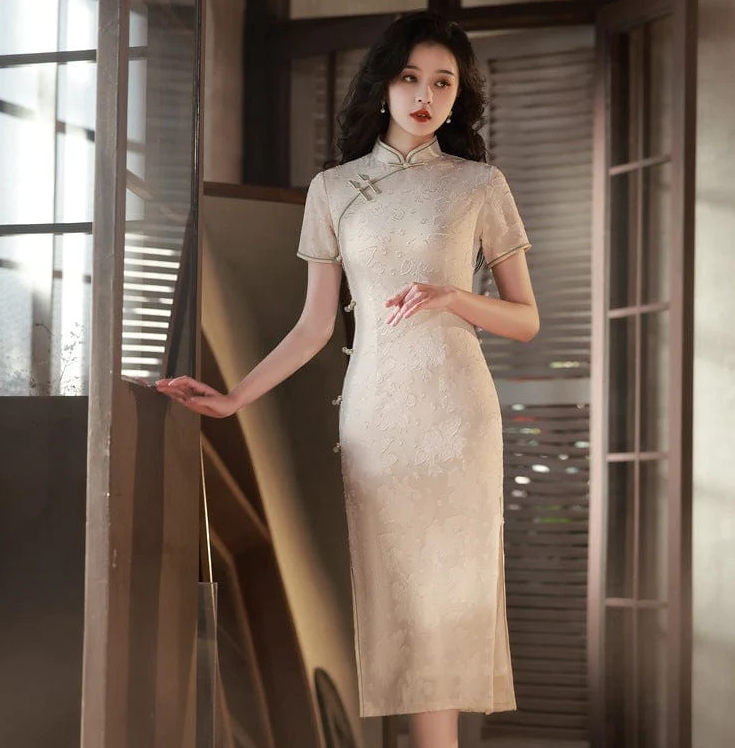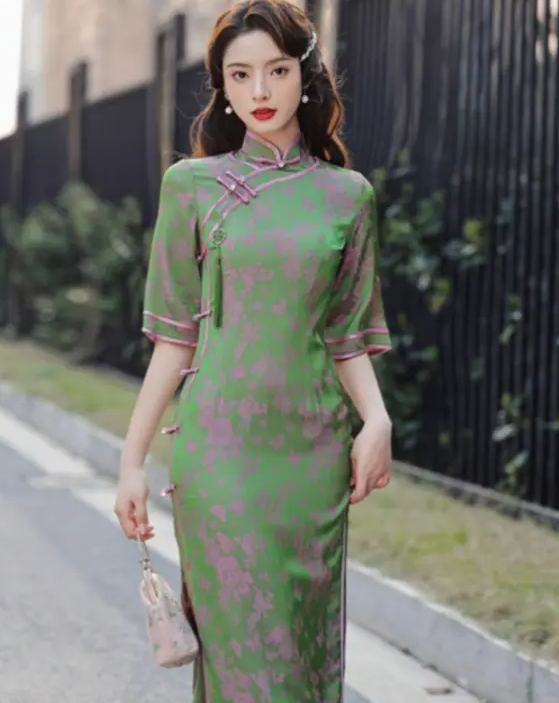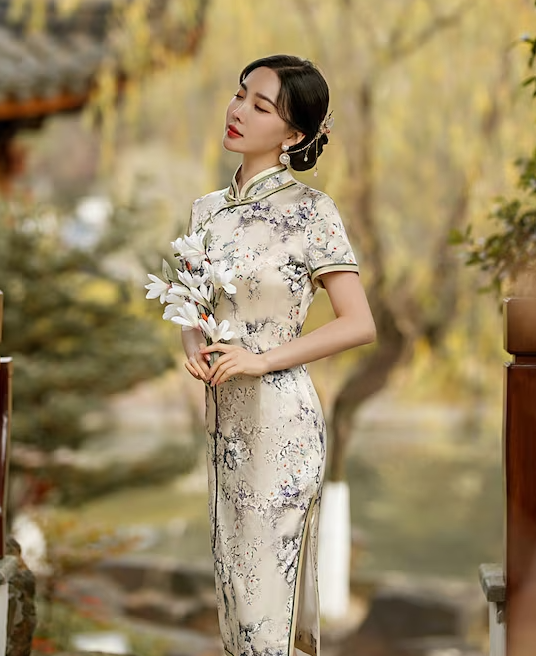To choose a qipao, consider its material, fit, color, pattern, and coordinate with suitable accessories.
Understanding Different Types of Qipaos
The Qipao, often known in Cantonese as the Cheongsam, is a traditional Chinese dress that has evolved over centuries. Recognized for its high collar, snug fit, and side slits, the Qipao captures the essence of Chinese femininity and grace. Over time, the designs, materials, and styles of the Qipao have transformed to meet the changing fashion trends and societal needs.

Traditional vs. Modern Designs
- Traditional Qipaos:
- Originating from the Manchu-ruled Qing Dynasty, the early versions of Qipaos were loose and covered most parts of the wearer’s body.
- Traditional designs often feature intricate embroidery and motifs such as dragons, phoenixes, and florals, symbolizing various virtues and values in Chinese culture.
- Made primarily of silk, they tend to be of high quality and crafted with great attention to detail.
- Modern Qipaos:
- As fashion evolved, so did the Qipao. Modern Qipaos are more figure-hugging and might show more skin.
- They might incorporate newer materials like satin or blended fabrics, and while they often retain elements of traditional embroidery, they might also have simpler patterns or even sequined details.
- Popular among younger generations, especially for events like proms or cocktail parties.
Variations Based on Regions and Occasions
- Shanghai Style:
- Known for its glamor and sophistication, the Shanghai Qipao rose to prominence in the 1920s and 1930s. It’s characterized by its tailored fit and luxurious materials. This style became synonymous with the cosmopolitan appeal of Shanghai during that era.
- Beijing Style:
- Reflects the more conservative and traditional sentiments of the North. These Qipaos tend to have higher collars and less ornate details, emphasizing modesty.
- Occasion-specific Qipaos:
- Weddings: White or red Qipaos, heavily embroidered with gold threads and symbols like the double happiness character, are preferred.
- Casual Wear: Made from comfortable materials like cotton or linen, these Qipaos are perfect for daily wear. They might have simpler designs and are often more affordable, typically ranging between $50 to $150.
- Festivals and Celebrations: Brightly colored with festive motifs, these Qipaos are made to celebrate special occasions like the Lunar New Year or Mid-Autumn Festival.
Selecting the Right Material
Choosing the appropriate fabric for a Qipao is essential for ensuring comfort, longevity, and aesthetic appeal. Different materials offer varied tactile sensations, drapes, and appearances. Here’s a detailed guide on some of the most popular materials used in crafting Qipaos and insights on their benefits, drawbacks, and maintenance.
Commonly Used Fabrics
- Silk:
- Origin: This natural protein fiber is obtained from the cocoons of silkworms. Silk has been deeply rooted in Chinese culture for millennia.
- Benefits: Soft to touch, lustrous, breathable, and provides a luxurious feel. Often considered the epitome of luxury when it comes to Qipao fabrics.
- Drawbacks: Delicate and can be prone to damage from excessive sunlight or moisture. Price can range from $50 to $500 per yard, depending on quality and type.
- Care: Dry clean recommended. Avoid direct sunlight when storing. Use padded hangers to maintain the shape.
- Satin:
- Origin: A weave, rather than a material, satin can be made from silk, polyester, or acetate, known for its glossy surface and dull back.
- Benefits: Smooth, shiny, and drapes well. It offers a polished look without the high cost of pure silk. Typically priced between $10 and $100 per yard.
- Drawbacks: Can snag or pull easily. Not as breathable as natural fibers.
- Care: Hand wash or machine wash on a gentle cycle. Avoid wringing. Iron inside out on low heat.
- Brocade:
- Origin: A class of richly decorative shuttle-woven fabrics, often made in colored silks and sometimes with gold and silver threads. Historically significant in Chinese culture for its intricate patterns.
- Benefits: Elaborate designs, textured feel, and can be weighty which provides a good drape.
- Drawbacks: Can be heavy and less breathable. Price varies widely based on intricacy and material, ranging from $30 to $300 per yard.
- Care: Dry clean only. Store in cool, dry places.
Benefits and Drawbacks of Each Fabric
When selecting the material for your Qipao, consider the occasion, your budget, and comfort. While silk offers unparalleled luxury, it comes at a premium price. Satin might be more affordable, but care needs to be taken to prevent snags. Brocade, with its historical significance and rich patterns, is perfect for grand occasions but might be too heavy for casual wear.
Caring for Different Materials
It’s crucial to ensure that the Qipao retains its beauty over time. Proper storage, gentle cleaning, and avoidance of direct sunlight or harsh chemicals can extend the lifespan of your dress. Investing in quality fabric ensures not just a stunning appearance but also durability, making the Qipao a treasured piece in your wardrobe for years to come.
Determining the Perfect Fit
A well-fitted Qipao is a testament to grace and elegance. The silhouette of the Qipao is designed to accentuate the natural curves of the body while exuding sophistication. Getting that perfect fit is, therefore, paramount. Here’s your guide to achieving the ideal fit, tailored just for you.
Importance of Tailoring in a Qipao
- Historical Context: In the golden era of Shanghai, tailor-made Qipaos were the norm. Skilled tailors would craft these dresses to fit the exact measurements of the wearer, ensuring a snug yet comfortable fit.
- Custom Experience: Unlike off-the-rack dresses, a tailored Qipao guarantees a unique piece. This ensures that the dress fits your body perfectly, enhancing your figure’s strengths and masking any perceived flaws.
- Cost and Value: Tailoring a Qipao can range from $150 for simpler designs to over $2000 for luxurious materials and intricate details. This investment ensures you own a piece that’s both unique and timeless.
Taking Measurements Accurately
- Bust: Measure around the fullest part, ensuring the tape remains horizontal. Typically, the bust size for Qipao wearers varies from 32 inches to 42 inches.
- Waist: Measure around the smallest part of your waist. Common waist measurements for Qipaos range between 24 inches and 34 inches.
- Hips: Measure around the widest part of your hips. This is crucial for the Qipao’s iconic side slits. Measurements usually range from 34 inches to 44 inches.
- Dress Length: From the base of the neck to the desired end point, whether it’s knee-length, mid-calf, or ankle-length.
- Tips: Always keep the measuring tape snug but not tight. It’s recommended to get someone else to take your measurements to ensure accuracy. You can refer to this guide for more detailed steps.
Common Fit Issues and How to Avoid Them
- Tightness Around the Hips: This can restrict movement and create an undesirable appearance. Ensure accurate hip measurements and add a half-inch for ease.
- Gaping Neckline: If the Qipao’s collar doesn’t sit flush against your neck, it’s too loose. Consider adjusting the neckline or opting for a design with a different collar shape.
- Bulging on the Sides: Indicates that the bust or waist area is too tight. Always add some margin to your actual measurements for comfort.
- Uneven Hem: This might be a result of uneven leg lengths or posture issues. A good tailor can adjust the hem to ensure it sits parallel to the ground.
Choosing the Right Color and Pattern
The allure of a Qipao isn’t just in its fit or fabric but also in its color and patterns. These elements carry significant weight in Chinese culture, expressing individual preferences, societal norms, and historical symbols. Making a well-informed choice can add depth to the aesthetics and the narrative your dress portrays.

Symbolism Behind Popular Colors in Chinese Culture
- Red:
- Significance: Red is deeply intertwined with Chinese culture and symbolizes luck, joy, and happiness. It’s a staple at weddings and festive occasions.
- Occasions: Ideal for weddings, New Year celebrations, and birthdays.
- Popularity: Among the top choices, with almost 60% of traditional Qipaos being red.
- Gold:
- Significance: Represents wealth, prosperity, and grandeur.
- Occasions: Used in combination with red for weddings or solo for grand events.
- Popularity: Often paired with intricate patterns, it’s a top choice for those seeking opulence.
- White:
- Significance: While often associated with purity and innocence, it can also be linked to mourning in traditional Chinese customs.
- Occasions: Modern weddings, casual events, but avoided at funerals.
- Popularity: Gaining traction, especially in modern Qipao designs.
- Green:
- Significance: Symbolizes health, prosperity, and harmony.
- Occasions: Spring events, outdoor parties.
- Popularity: A fresh choice, especially among the younger demographic.
Deciding Based on Complexion, Occasion, and Personal Preference
- Complexion:
- Fair Skin: Bright colors like cherry red, royal blue, or emerald green can be complementary.
- Medium Skin: Earthy tones like beige, mustard, and teal can be flattering.
- Darker Skin: Jewel tones such as amethyst or topaz, or even bright shades like gold or coral, work wonders.
- Occasion:
- Formal events call for solid colors or intricate patterns.
- Casual events allow for playful patterns and lighter colors.
- Personal Preference: Your comfort and identification with a color or pattern matter most. Always trust your instincts!
Popular Motifs and Their Meanings
- Dragons: A symbol of power, strength, and good luck. Often found on Qipaos worn by brides or for significant events.
- Phoenix: Representing grace, virtue, and the union of masculine and feminine. A common motif on wedding Qipaos.
- Peonies: Symbolizing prosperity and honor. A popular floral design on casual and formal dresses alike.
- Bamboo: Represents resilience, integrity, and grace. A favorite for those seeking elegance with a touch of nature.
Accessorizing Your Qipao
While the Qipao stands as a magnificent piece on its own, the right accessories can accentuate its beauty. However, it’s a delicate balancing act, ensuring your accessories complement rather than overshadow your Qipao. This guide will steer you towards making choices that align with the elegance of your dress.
Selecting Matching Shoes, Jewelry, and Handbags
- Shoes:
- Traditional Approach: Cloth shoes with embroidered patterns or simple heels in solid colors.
- Modern Spin: High heels, preferably in colors that match the primary color of the Qipao. A popular choice is the stiletto heel which can range in price from $50 to $1000, depending on the brand and material.
- Occasion-based: For weddings or grand events, embellished or crystal-studded heels make a statement. For casual outings, ballet flats or sandals work well.
- Jewelry:
- Earrings: Opt for studs or dangle earrings that reflect any patterns on the Qipao. Pearls, for instance, are a timeless choice.
- Necklaces: A simple chain with a pendant, especially if the Qipao has a high collar. For a lower neckline, chokers or medium-length necklaces can be flattering.
- Bracelets: Thin bangles or a delicate bracelet add a touch of elegance without being overpowering. Jade bracelets, a symbol of purity and protection, are a traditional favorite.
- Handbags:
- Clutches: Small, embellished clutches are suitable for formal events. Prices can range from $30 for basic designs to over $3000 for luxury brands.
- Shoulder Bags: For a more casual look, choose bags that are medium-sized and in a color that complements your Qipao. Leather or embroidered silk bags are prevalent choices.

How to Balance Elegance Without Overshadowing the Qipao
- Stay Minimalistic: The Qipao is already a statement piece. Limit your accessories to 2 or 3 key items. For instance, if wearing large earrings, you might skip the necklace.
- Harmony in Colors: Ensure your accessories are in the same color family as your Qipao. If your dress is red with gold patterns, a gold clutch and gold shoes would be harmonious.
- Quality Over Quantity: Instead of multiple pieces, choose one or two high-quality accessories. A well-crafted jade bracelet or a luxury clutch can elevate your look.
- Remember the Occasion: For formal events, lean towards understated elegance. For casual outings, you have more leeway to be playful with your accessories.







